Humongous Book of Cartooning Christopher Hart
Visit to download the full and correct content document: https://ebookmass.com/product/humongous-book-of-cartooning-christopher-hart/



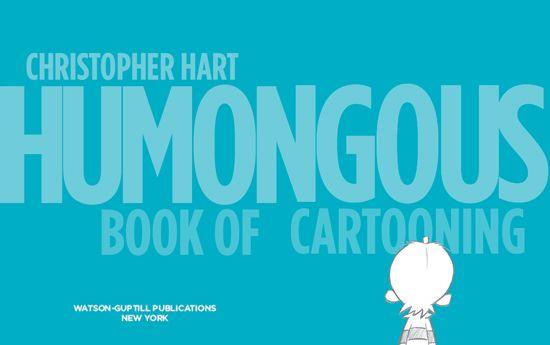
Copyright © 2009 by Christopher Hart All rights reserved. Published in the United States by Watson-Guptill Publications, an imprint of the Crown Publishing Group, a division of Random House, Inc., New York. www.crownpublishing.com | www.watsonguptill.com WATSON-GUPTILL is a registered trademark and the WG and Horse designs are trademarks of Random House, Inc. Library of Congress Cataloging-in-Publication data: 2009927070
v3.1
eISBN: 978-0-8230-8558-3
SPECIAL THANKS TO
Lauren Shakely
Candace Raney
Victoria Craven
James Waller
Brian Phair
Autumn Kindelspire
And, of course, YOU, THE READER!
—Chris

From the Author
Drawing Cartoon Characters’ Heads
Drawing the Facial Features
Drawing the Entire Figure
Designing a Character
Costuming a Character
Conveying Body Language
Designing Basic Layouts
Special Characters: Robots
Special Characters: Animals
Special Characters: Fantasy Creatures Index
Cover Title Page Copyright Acknowledgments
FROM THE AUTHOR

Do you enjoy drawing, but are frustrated that you aren’t getting to the next level? Would you like to improve your drawing skills? That’s exactly what this book is designed to help you do. It will give you practical insights into cartooning that you can apply immediately to your drawings, so that you can see results right away.
Humongous Book of Cartooning is more than your average tutorial. It’s like having a personal mentor by your side while you draw. In this book, I cover professional techniques that I have personally distilled over my years in cartooning into easy-to-grasp lessons. I have �lled the book from beginning to end with scores of tips, which will give you a clear understanding of the techniques I use. As a result, you’ll �nd that you can begin drawing with a professional �air from the very �rst chapter. What a thrill it will be to see your cartoons spring to life and surpass even your own expectations! I think you’ll get a real kick out of it.
There’s a great deal value in being able to successfully recreate the images in this book. After all, many cartoonists make a
handsome living drawing characters that have been designed by other people. Whether they work on comic books, animated TV shows, or animated �lms, virtually all cartoonists begin their professional careers by drawing other people’s characters. If, however, your goal is to create something totally original, learning to draw the characters in this book will teach you all the principles you need to get started on the right track.
This book covers the widest spectrum of subjects, from cartoon people to cartoon animals, funny robots, costumes, layout, backgrounds, fantasy creatures, expressions, drawing action, and more.
Everyone needs a little encouragement. I got it when I was still a high school student, by attending some life drawing classes taught by animators at the Cartoonist’s Union in North Hollywood, California. I was well situated, living in the �lm capital of the world, but I was also ambitious. I sought out mentors in the form of animation directors and producers who looked over my portfolio and gave me advice along the way. You may not live in Los Angeles or have any contacts in the cartooning and animation world. Not to worry—because we’re about to level the playing �eld, or actually tilt it in your favor. In these pages, you’ll get all the information that I had when I was starting out—and more. It’s my way of giving something back, and I’m grateful to have had the opportunity to do so.
I’m delighted to have you on board.
Onward!

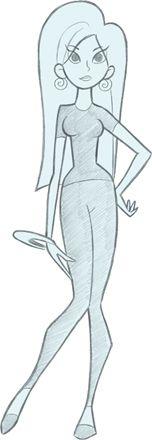
1
Drawing Cartoon Characters’ Heads
The basis for drawing a cartoon character’s head isn’t the eyes, or the mouth, or any particular facial feature. It’s the shape of the head itself—the outline. A circle is the most basic head shape, but it’s only one of many. The head can be stretched, adjusted, or cut o� to create funny forms. That’s why cartoonists begin by drawing the basic head shape �rst. It dictates where the features should go.
Give the head shape some thought. Put as much creative juice into drawing the shape of the head as you would, for instance, into drawing of the character’s eyes. Too often, beginning artists focus exclusively on the features. This is a mistake—but not one that you’re going to make!
NINE BASIC HEAD SHAPES
By using and modifying nine simple shapes, you can draw just about any type of cartoon character’s head. We’re going to see how each shape can be turned into a lively character in only a few steps. Here are the nine basic shapes.




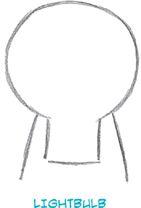




Circle (Squirrel)
Circles work equally well for people and animals, but notice how a round shape makes a character—human or animal—look young, cute, or retro (or a combination of all three). Place the features on a circular face symmetrically. The lower you move the features on the circle, the cuter the character will be. (A tiny muzzle is necessary for “cuteness.”)


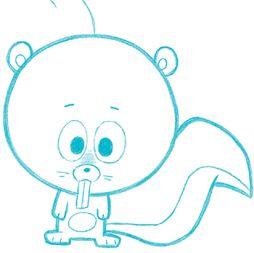
Bump-out Shape (Bear Cub)
The bump-out shape greatly exaggerates the prominence of the cheek and can therefore make a cute character even cuter. It also widens the face, giving the character greater presence. It’s mainly used for human characters but can also be applied to animals, as with this bear cub. The bump-out should always appear low on the face, and it always occurs on the cheek on the far side of the face.
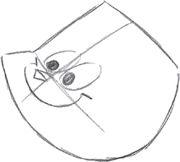


Rounded Triangle (Teenage Guy)
This idealized head shape, wide at the top and narrow at the chin, works mainly for teenage characters: Hanging the ears low on the head is a sign of youth. Most of his hairdo is drawn within the outline of his head. Sweep the hair to one side, which makes for a more dramatic look.


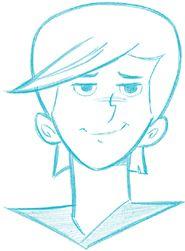
Oval (Teenage Girl)
The oval head shape is a particularly good look for female characters. You can make the head even more feminine by tapering the chin to a softened point. A long, thin neck is a nice complement to an oval-shaped head. Since this character has a lot of hair, I’ve left room for it by giving her an extra-big forehead.

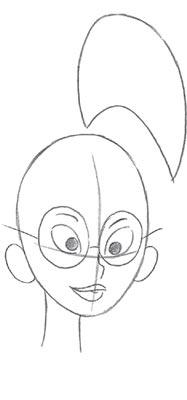

Lightbulb (Mad-Scientist Villain)
This kind of character is a favorite of mine. He’s not just evil—he’s funny-evil. The lightbulb shape is perfect for mad scientists: They typically have big craniums, in which they store their maniacal plans to take over the world. But the rest of the face is skinny, re�ecting the cartoon stereotype that casts scientists as physically meek. (And notice the sunken cheeks—they’re a sure sign of evil.)



Cut-o� Circle (Goth Girl)
The cut-o� circle gives a severe, stylized look, so you need to use it for severe, stylized characters. Notice how this goth girl’s bangs chop o� the tops of her eyes, repeating the way the top of her head is chopped o�. The cut-o� look should be very abrupt. Don’t soften the edges of the head.



Modi�ed Half-Moon (Cartoon Dad)
This is the quintessential head construction for the “retro” dad that not-so-handy Sunday afternoon barbecue king. Keep the features well up on the head so that there is plenty of chin— stereotypical dads always have sizable chins. And don’t give him a cheek-bump-out. That would make him too “cute” not lean enough. Dad always has well-groomed hair and a fairly thick neck.
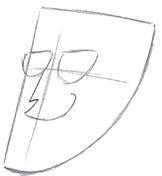


Rectangle (Fox)
Some shapes, like this rectangle, are so strong that they can be used for the entire character—not just the head. This fox’s snout breaks the outline, but other than that he’s just one big vertical box. Notice that there’s no break whatsoever between the head and the body. It’s a highly stylized look—and as far from a real fox as you can get without the character becoming unrecognizable. It’s mainly his markings, bushy tail, pointy ears, and snout that give him away.



A CAST OF CHARACTERS
Now we’re going to develop a whole cast of appealing cartoon characters, keeping in mind the need to draw the basic head shape �rst. We’ll do some animals and some people, since both are essential in cartooning. By following the steps, you’ll be able to isolate the areas that present you with challenges and, even more important, recognize where your strengths lie.
By the way, I don’t agree with the point of view that says you should focus your energy on correcting weak points before moving on. Doing so is bound to be draining and frustrating, and it won’t bring you to a higher overall skill level.
To raise your artistic skills, push yourself in those areas where you show signs of strength, where you excel, or where you are most inspired and driven. Work on improving your weaknesses as the need arises. But don’t slow your progress to a grinding halt simply because you have weaknesses. Keep pressing your boundaries. See where your talent leads you.








































